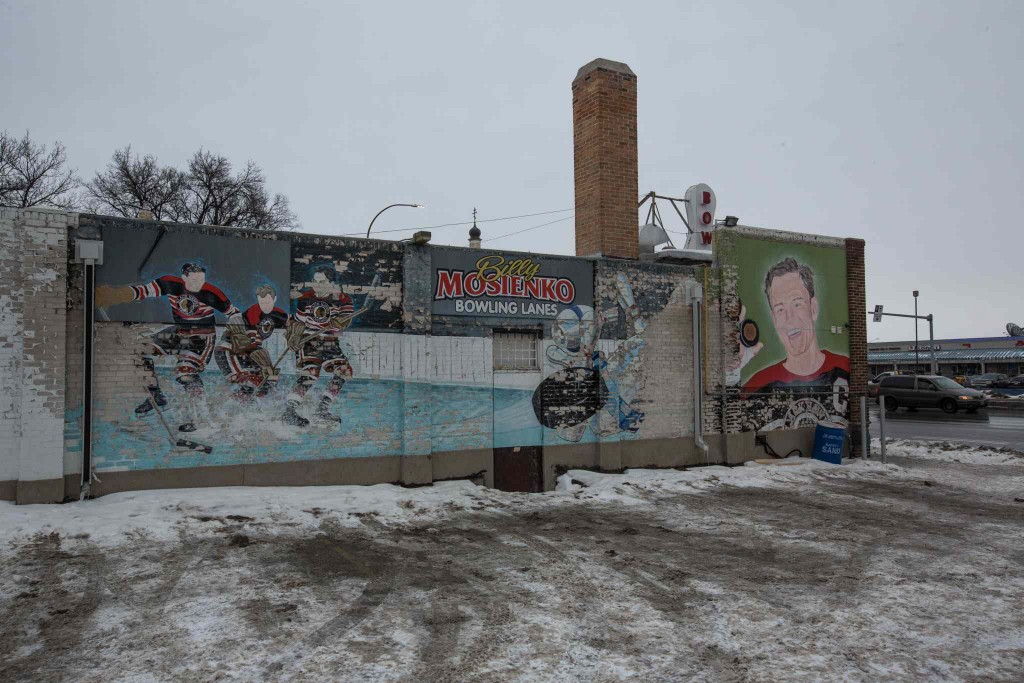Mosienko Mural Needs Makeover
A mural celebrating perhaps the most unbreakable NHL record of all may be on the cusp of getting a much-needed makeover.
The mural of Chicago Blackhawks right-winger Billy Mosienko holding up three pucks after scoring the fastest hat trick in NHL history is a peeling shadow of its former self outside the bowling alley the late NHL Hall of Famer used to own.
Tom Ethans, executive director of Take Pride Winnipeg, said he’s in the process of sending out letters to foundations and other potential donors and hopes to use the proceeds to overhaul or repaint Mosienko’s mural. It has adorned the south wall of Billy Mosienko Bowling Lanes near the corner of Main Street and Redwood Avenue since the mid-1990s.

MIKE DEAL / WINNIPEG FREE PRESS The decaying mural on the south side of the Billy Mosienko Bowling Lanes on Main Street. 160218 – Thursday, February 18, 2016
“It’s something that is of great historical value to Winnipeg and Manitoba sports. It’s a National Hockey League record that will never be broken,” Ethans said.
The challenge in fixing the existing painting is its canvas is a combination of plywood and brick. The elements are particularly hard on painted bricks, as evidenced by the fact that two of the pucks on Mosienko’s right hand and the crest on his jersey are barely recognizable. The third puck, which is on the plywood, looks brand new. Most of the murals in town are the product of Take Pride Winnipeg. Ethans said it generally costs about $10 per square foot to paint one, meaning a Mosienko replacement will cost several thousand dollars.
There might also be some funding available from the North End BIZ (Business Improvement Zone). Executive director Astrid Lichti said it has partnered with Take Pride Winnipeg on a number of murals in the past.
“We haven’t had any requests from the business to upgrade (its) mural. The last one we had was from Kelekis Restaurant four or five years before they closed. (The Mosienko mural) is something we’ve maintained an interest in,” she said, and added the funding process is as simple as approaching the BIZ’s board and requesting the funds.
Jason Britton and his dad, Brian, bought Billy Mosienko Bowling a number of years ago. He said he has been thinking of refurbishing the mural for a while but other repairs, such as a leaky roof, have taken priority.
“Spending on something that doesn’t make money is difficult sometimes. Bowling isn’t what it used to be,” he said.
Mosienko opened Cooper-Mosienko Lanes with fellow Blackhawk Joe Cooper in 1947. He bought out his teammate a number of years later. Two of Mosienko’s children are hopeful that the mural can be upgraded.
“Isn’t it sad?” said Brian Mosienko, who ran the facility for many years. “The building is old and it sweats, which peels the paint on the wall. It shouldn’t have been put on the brick, it should have been put on wood.”
Bill Mosienko Jr. worked at his dad’s business as a kid and it helped put him through university.
“I worked behind the counter and sold drinks, cigarettes and candy bars. When the leagues were on, my dad would go and visit, talk to the people and make them feel at home,” he said.
There are a number of paintings inside the bowling alley of his dad but none is as iconic as the one outside, which is one of the best-known pictures from NHL history. Mosienko died in 1994 at the age of 72. He was inducted into the Hockey Hall of Fame in 1965 and into the Manitoba Sports Hall of Fame in 1980. Although he scored 258 goals, he is best known for just three of them. On March 23, 1952, on the final night of the regular season, Mosienko notched three goals in 21 seconds in the third period against the New York Rangers and goaltender Lorne Anderson, setting a record that stands to this day. He very nearly had a fourth goal 45 seconds later, but he hit the post. Brian Mosienko said his dad could have lived anywhere in North America after his NHL career ended in 1955, but he chose to return to his roots.
“He loved Winnipeg and he loved the North End. His family and friends were all there,” he said.
‘It’s something that is of great historical value to Winnipeg and Manitoba sports’ — Tom Ethans, executive director of Take Pride Winnipeg
March 10, 2016
